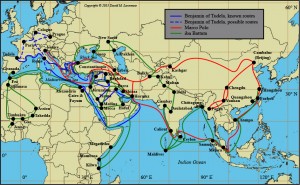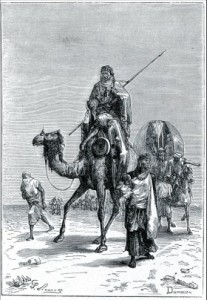The Itinerary of Benjamin of Tudela
MECHANICSVILLE, Va.—Benjamin was a twelfth century Jewish scholar from the town of Tudela in Navarre, in what is now Spain.
In 1165, Benjamin set off on a journey across the Iberian Peninsula across southern Europe in to Asia Minor, the Levant, Persia, Arabia, and Egypt.
No one is completely sure why Benjamin undertook the journey. It may have been out of a desire to make trade connections with other communities along the way. He may have been wanting to reach out to Jewish communities increasingly fragmented by the strife of the Crusades. Or he may have wanted to identify places where other traveling Jews could find sanctuary on their journey.
Whatever the motive, the Itinerary of Benjamin of Tudela is an amazing catalog of twelfth century Jewish communities, giving numbers of Jews in each as well as naming the leaders within those groups. For example, he says of the Greek city of Thebes:
“From Thebes it is a day’s journey to Egripo [39], which is a large city upon the sea-coast, where merchants come from every quarter. About 200 Jews live there, at their head being R. Elijah Psalteri, r. Emanuel, and R. Caleb. (Benjamin of Tudela 1840, 8).”
Unless you have a strong interest in a census of medieval Jewish communities, this is not terribly interesting. But Benjamin relayed a lot of other detail about the places he saw.
“A three days’ voyage brings one to Abydos, which is upon an arm of the sea which flows between the mountains, and after a five days’ journey the great town of Constantinople is reached. It is the capital of the whole land of Javan, which is called Greece. Here is the residence of the King Emanuel the Emperor. … The circumference of the city of Constantinople is eighteen miles; half of it is surrounded by the sea, and half by land, and it is situated upon two arms of the sea, one coming from the sea of Russia, and one from the sea of Sepharad.
All sorts of merchants come here from the land of Babylon, from the land of Shinar, from Persia, Media, and all the sovereignty of the land of Egypt, from the land of Canaan, and the empire of Russia[42], from Hungaria, Patzinakia[43], Khazaria[44], and the land of Lombardy and Sepharad. It is a busy city, and merchants come to it from every country by sea or land, and there is none like it in the world except Bagdad, the great city of Islam. In Constantinople is the church of Santa Sophia, and the seat of the Pope of the Greeks, since the Greeks do not obey the Pope of Rome. … Close to the walls of the palace is also a place of amusement belonging to the king, which is called the Hippodrome, and every year on the anniversary of the birth of Jesus the king gives a great entertainment there. And in that place men from all the races of the world come before the king and queen with jugglery and without jugglery, and they introduce lions, leopards, bears, and wild asses, and they engage them in combat with one another; and the same thing is done with birds. No entertainment like this is to be found in any other land (9).”

Map of the routes taken by several Middle Age explorers of the Old World. Tracks in blue are those of the twelfth century Jewish explorer Benjamin of Tudela; tracks in red are of the thirteenth century Christian explorer Marco Polo; and tracks in green are of the fourteenth century Muslim explorer ibn Battuta. The religions of the explorers are important, as each man viewed the the lands and seas he traveled through with a different cultural lens. Redrawn from other sources. Mercator Projection with a nominal scale of 1:67,500,000.
While the Itinerary is dense in terms of information content, and while passages such as the above-cited segment about Constantinople are fascinating, the structure of the Itinerary is repetitive and reading it at times is a chore—as exciting as reading sheets from a nineteenth century U.S. Census.
But, on balance, the price of enduring the repetition is worth the peek the Itinerary offers of the Medieval world.
REFERENCES
Benjamin of Tudela. 1907. The Itinerary of Rabbi Benjamin of Tudela. Critical Text, Translation and Commentary by Marcus Nathan Asher. New York: Philipp Feldheim, 1907. Reprinted Gloucester, United Kingdom: Dodo Press.

